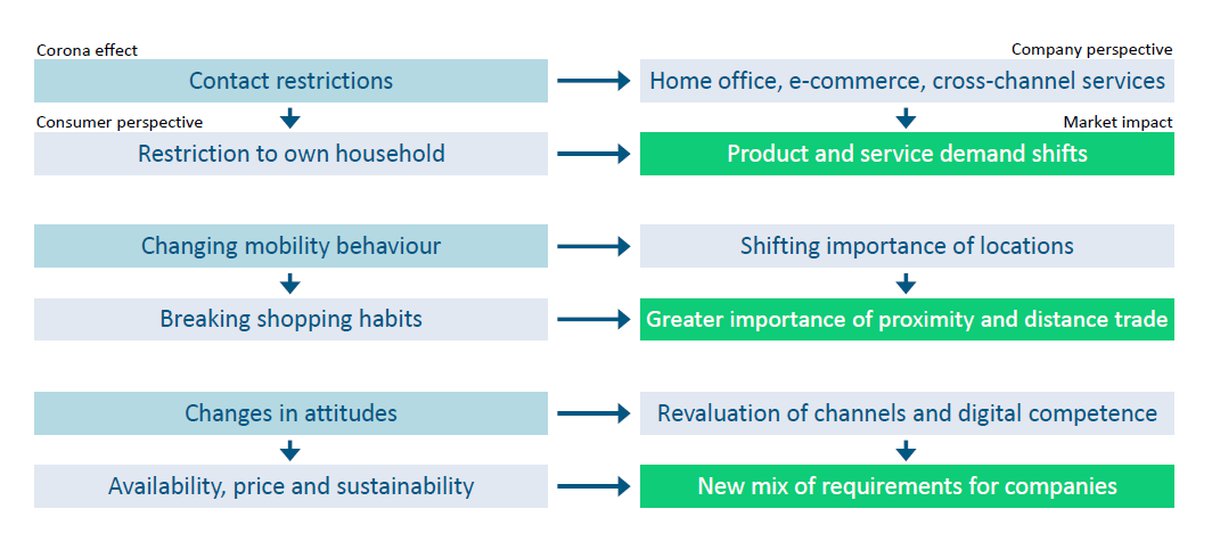Commerce Report Switzerland 2021: Management Summary «Barometer»

Assessment of the situation in Swiss commerce: A Silver Lining.
Extract of the Management Summary «Barometer» of the Commerce Report Switzerland 2021
It goes without saying: the Covid-19 pandemic is a major disaster for the world. But as always with far-reaching events, new opportunities open up for some of those affected. Being one of the more fortunate is no merit. But it deserves recognition if you are able to take advantage of these opportunities, redirect the resources available and contribute to stabilisation and general welfare in a difficult situation. This was true in 2020 and still applies to many employees and companies in the consumer goods sector.
The Swiss consumer goods sector took advantage.
Datatrans Ltd, as the client, and the University of Applied Sciences and Arts Northwestern Switzerland (FHNW) are taking the changes in the distribution of physical consumer goods caused by the coronavirus crisis as an opportunity to expand the series of studies published between 2009 and 2020 on the development of sales to consumers by two special issues. This first publication of Barometer explores the current state of Swiss retail sector. The second edition, which will be published at the beginning of November 2021, and will look at developments in the supplier landscape and business models. As usual, the study results are primarily derived from the statements of the experts on the study panel.
Corona: Experience and impact
2020 – a roller-coaster ride!
It has been a real roller-coaster ride for suppliers of the consumer goods sector in the first year of the coronavirus crisis, 2020. It began at the beginning of March with a shocking realisation, which consumers responded to with panic buying of necessities on the one hand and with reluctance to shop on the other. Would furniture, books and clothing be bought at all? The outbreak was quickly followed by the first lockdown, occupational protection measures, working-from-home arrangements, an explosive e-commerce boom, major shifts in product ranges, serious logistics and availability problems, catch-up effects after the reopening of the shops, continuous ups and downs and the chaotic political environment – and all this with an unstoppable second wave approaching. The protective measures reached such a level that the second lockdown could be postponed into the new year following the Christmas sales period. Meanwhile, global supply chains had completely been thrown into disarray: all kinds of product groups and transport routes were struggling with persistent bottlenecks and price increases that had not previously been seen for a long time.
One of the surprises of this year’s interviews is how well the companies were able to overcome all of this. It was not only the transition to remote work that went surprisingly smoothly. In other areas, too, employees brilliantly demonstrated a willingness to adapt as well as determination when it came to doing the right thing in new situations or learning quickly. Several study participants described this experience as a highlight of the year – and would like to maintain this pragmatic approach in the future.
What will be the new normal? Nobody knows the answer yet!
In terms of the market, the coronavirus has had a range of effects, the most important of which are shown in Fig. 1. In many areas, the crisis has acted as an accelerator for existing trends, such as the shift from the stationary to the networked world of products and services, the importance of smartphones and the desire for a more sustainable world.
What is new and unexpected on the other hand are the change in the customer’s scope of movement, the increased importance of home and the rediscovery of doing things oneself, for example cooking. Changing daily routines can have far-reaching consequences for trade: high-footfall locations and district stores have to be reassessed. The interplay of services provided locally and those provided online from a distance will adjust to a new equilibrium.

Fig. 1: Coronavirus consequences and their impact on the market.
Other topics of the Management Summary:
- Expectations for the current year and beyond
- 2020 – a surprisingly strong year for the consumer goods sector
Click on study archive to obtain the complete study 2021 in German and the complete management summary in English and French for free, as well as all past reports.